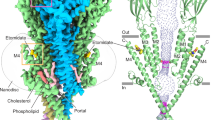Abstract
THAT d-tubocurarine (DTC) is convulsant when applied topically to the cerebral cortex has been known for many years but the mechanism of its action is still unclear1–3. Other neuromuscular blocking drugs such as gallamine, decamethonium and dihydro-β-erythroidine do not have this convulsive property4 and the usual comparison is with known convulsants such as picrotoxin and strychnine1,4,5. This suggests that different receptors to those in the periphery are involved in the convulsive action of DTC and it is possible that the central receptors with which DTC interacts may be those mediating cortical inhibitory processes. Blockade of these receptors would result in uncontrolled excitation and lead to paroxysmal discharges. As γ-aminobutyric acid (GABA) is now thought to be the cortical inhibitory transmitter6, we have examined the interactions of DTC and GABA, applying both substances by microiontophoresis. In addition we have studied the effects of microiontophoretically applied DTC on the inhibition of cortical neurones produced by direct shocks to the adjacent cortical surface7,8 and we have also compared DTC with other convulsants applied to the same neurones, from the same pipette.
This is a preview of subscription content, access via your institution
Access options
Subscribe to this journal
Receive 51 print issues and online access
$199.00 per year
only $3.90 per issue
Buy this article
- Purchase on Springer Link
- Instant access to full article PDF
Prices may be subject to local taxes which are calculated during checkout
Similar content being viewed by others
References
Chang, H., J. Neurophysiol., 16, 221 (1953).
Feldberg, W., Malcolm, J. L., and Darian Smith, I., J. Physiol., 138, 178 (1957).
Rumagai, H., Sakai, F., and Otsuka, Y., J. Neuropharmac., 1, 157 (1962).
Banerjee, U., Feldberg, W., and Georgiev, V. P., Br. J. Pharmac., 40, 6 (1970).
Bhargava, V. K., and Meldrum, B. S., Br. J. Pharmac., 37, 112 (1969).
Krnjević, K., Nature, 228, 119 (1970).
Curtis, D. R., Pharmac. Rev., 15, 333 (1963).
Krnjević, K., Randić, Mirjana, and Straughan, D. W., J. Physiol., 184, 78 (1966).
Straughan, D. W., Neal, M. J., Simmonds, M. A., Collins, G. G. S., and Hill, R. G., Nature, 233, 352 (1971).
Hill, R. G., Simmonds, M. A., and Straughan, D. W., Br. J. Pharmac., 44, 807 (1972).
Curtis, D. R., and Felix, D., Brain Res., 34, 301 (1971).
Biscoe, T. J., Duggan, A. W., and Lodge, D., J. Physiol., 222, 141P (1972).
Everett, A. J., Lowe, L. A., and Wilkinson, S., Chem. Commun., 1020 (1970).
Johnson, E. S., Roberts, M. H. T., and Straughan, D. W., Br. J. Pharmac., 38, 659 (1910).
Author information
Authors and Affiliations
Rights and permissions
About this article
Cite this article
HILL, R., SIMMONDS, M. & STRAUGHAN, D. Convulsive Properties of d-Tubocurarine and Cortical Inhibition. Nature 240, 51–52 (1972). https://doi.org/10.1038/240051a0
Received:
Issue Date:
DOI: https://doi.org/10.1038/240051a0
This article is cited by
-
Effects of acetylcholine and cholinergic transmission blockers on neuronal spike activity in the cat motor cortex associated with conditioned reflex
Neurophysiology (1990)
-
Vertical crustal movements of the Andes in Peru
Nature (1975)
-
Strychnine as an anticholinesterase: In vitro studies with rat brain enzymes
Experientia (1974)
Comments
By submitting a comment you agree to abide by our Terms and Community Guidelines. If you find something abusive or that does not comply with our terms or guidelines please flag it as inappropriate.



